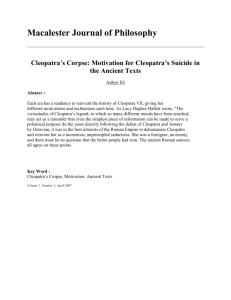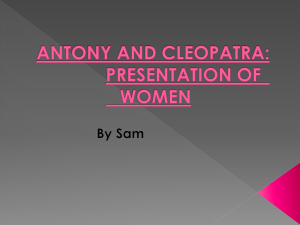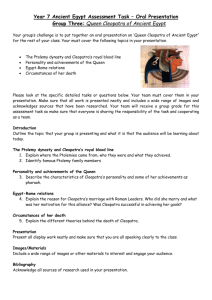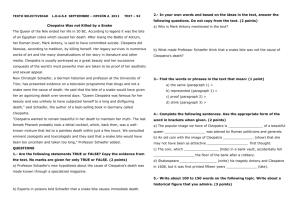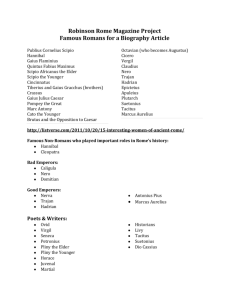the unconventional characterization of cleopatra in bernard shaw's
advertisement
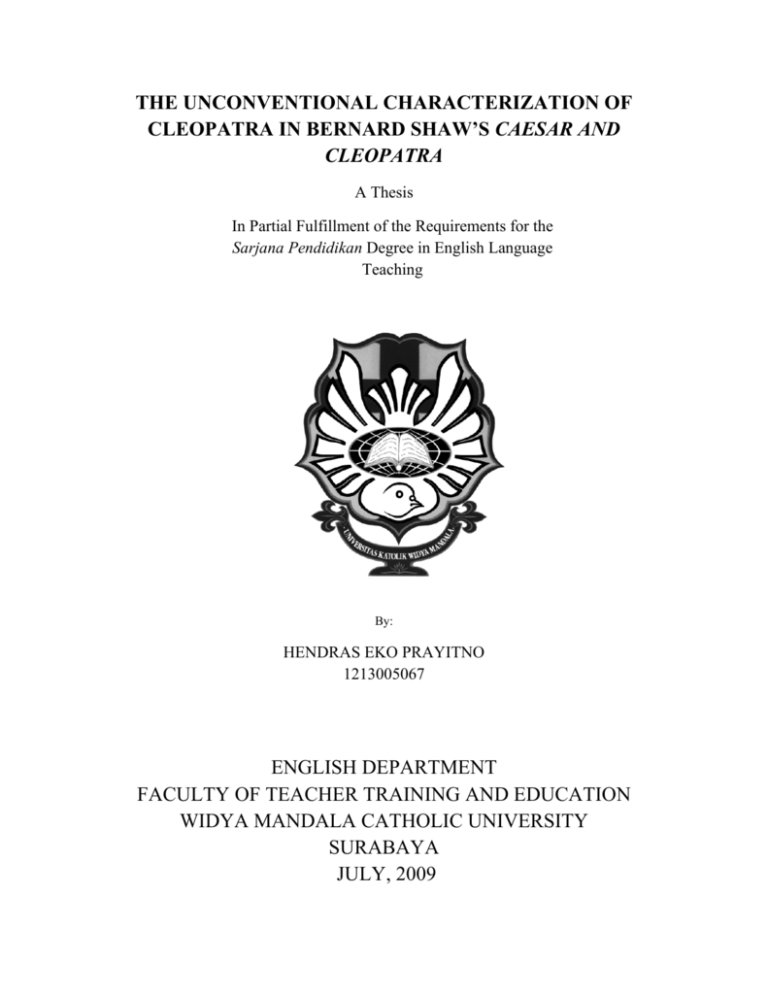
THE UNCONVENTIONAL CHARACTERIZATION OF CLEOPATRA IN BERNARD SHAW’S CAESAR AND CLEOPATRA A Thesis In Partial Fulfillment of the Requirements for the Sarjana Pendidikan Degree in English Language Teaching By: HENDRAS EKO PRAYITNO 1213005067 ENGLISH DEPARTMENT FACULTY OF TEACHER TRAINING AND EDUCATION WIDYA MANDALA CATHOLIC UNIVERSITY SURABAYA JULY, 2009 ACKNOWLEDGEMENTS First of all, the writer would like to express his greatest gratitude and honor to Almighty God for His blessing, love and support for the writer. The writer believes that without Him, the writer would never have been able to finish this study especially this thesis. Besides, the writer also wants to express his deepest gratitude to the following people who have helped and supported him in finishing his thesis: 1. Drs. Antonius Gurito, his first advisor, who has given his precious time to guide the writer and give him many good suggestions for the writer in working on his thesis. 2., B. Himawan Setyo Wibowo, M.Hum, the second advisor, who also has helped and guided the writer patiently in completing his thesis. 3. The writer’s beloved father, mother, and brother for always giving support to the writer during his study from the very beginning. 4. Ruth Megayanti S., Samuel Tandio, Anastasia Maya S.W., the writer’s friends for their help and big support for the writer to finish his thesis. 5. All the writer’s friends at English Department of Widya Mandala Catholic University, who have encouraged him in finishing his thesis soon. 6. All the lecturers and staff of English Department of Widya Mandala Catholic University 7. All the writer’s private students, especially Joshua Sebastian and Sigit Hartono. 8. The Paratha Bhakti foundation, especially Sr. Tristiani, Sr. Benigna, Sr. Agatha Linda Chandra, for their valuable support so that the writer can finish his study. The Writer TABLE OF CONTENTS APPROVAL SHEET (1) .........................................................................................i APPROVAL SHEET (2) ........................................................................................ii ACKNOWLEDGEMENT .....................................................................................iii TABLE OF CONTENTS .......................................................................................v ABSTRACT ..........................................................................................................vii CHAPTER I. INTRODUCTION ........................................................................ 1 1.1 Background of the Study..........................................................1 1.2 Statement of the Problem..........................................................5 1.3 Objective of the Study..............................................................5 1.4 Significance of the Study..........................................................5 1.5 Scope and Limitation of the Study...........................................6 1.6 Definition of Key Terms...........................................................6 1.7 Organization of the Thesis........................................................7 CHAPTER II. REVIEW ON RELATED LITERATURE....................................8 2.1 Elements of Drama …...............................................................8 2.1.1 Plot ....................................................................................8 2.1.2. Character...........................................................................9 2.1.2.1. Characterization ..................................................11 2.1.3. Setting.............................................................................14 2.1.4. Themes.............................................................................15 2.2 The Conventional Characterization of Cleopatra.....................16 CHAPTER III. RESEARCH METHODOLOGY...............................................20 3.1 The Research Design ..............................................................20 3.2 Source of Data …………........................................................21 3.3 The Research Instruments ......................................................22 3.4 Procedure of Collecting the Data ...........................................22 3.5 Procedure of Data Analysis.....................................................24 CHAPTER IV. FINDING AND DATA ANALYSIS OF THE FINDINGS............................................................................................................26 4.1 Basic Qualities of Cleopatra ……...........................................26 4.1.1 Cleopatra’s Physical Qualities .........................................26 4.1.2 Cleopatra’s Social Relationship ...................................... 27 4.1.2.1.Cleopatra’s Relationship with Ftataeeta..............27 4.1.2.2. Cleopatra’s Relationship with Caesar.................33 4.1.2.3 Cleopatra’s Relationship with Rufio...................46 4.1.3 Cleopatra’s Mental Qualities ...........................................49 4.2 How Cleopatra See Herself ....................................................53 4.3 How Cleopatra Develops During the Story ..........................54 4.4 The Unconventional Characterization of Cleopatra...............56 4.4.1 The Unconventional Physical Characterization of Cleopatra.................................................................................57 4.4.2 The Unconventional Mental Characterization of Cleopatra................................................................................57 4.4.2.1 Cleopatra’s Fear towards Caesar.......................58 4.4.2.2 Cleopatra’s Fear towards Ftatateeta..................61 4.4.2.3 Cleopatra’s Cowardice and Lack of Idea When She is in Chaotic Situation................................62 4.4.2.4. Cleopatra’s Plain Reaction for Her Failure in Becoming Sole Ruler of Egypt..........................63 4.5 The Reaction of Other Characters Towards the Unconventional Characterization of Cleopatra......................64 CHAPTER V. CONCLUSION AND SUGGESTION.......................................71 5.1 Conclusion ..............................................................................71 5.2 Suggestion ..............................................................................73 BIBLIOGRAPHY ...............................................................................................74 APPENDICES 1. Synopsis of the Play ................................................................77 2. Biography of Bernard Shaw ....................................................79 3. The Play, Caesar and Cleopatra .............................................82 ABSTRACT Prayitno, Hendras Eko. 2009. The Unconventional Characterization of Cleopatra in Bernard Shaw’s Caesar and Cleopatra. Thesis. Program Studi Pendidikan Bahasa Inggris FKIP Universitas Katolik Widya Mandala Surabaya. Advisor: 1. Drs. Antonius Gurito 2. Drs. B. Himawan Setyo Wibowo, M.Hum Key Words: Character, Unconventional characterization. Literature is one of the main principles of a culture because it contains the records of people’s value, their thoughts, their problems and conflict, in short, it represent their way of life. That is why literature is worth study to be learnt by the students or people in general. There are several genres of literature, one of them is drama. The play Caesar and Cleopatra is a drama which is adapted from a famous biographical history about Julius Caesar and Cleopatra. The playwright of this play, Bernard Shaw changed the characterization of Cleopatra into unconventional one which is somewhat different from the common characterization of her that has been widely known by people through the ages. Here, the writer is going to analyze the unconventional characterization of Cleopatra and also the reaction of the other characters towards her unconventional characterization. The writer’s study belongs to a qualitative research. To collect the data, the writer reads the play for several times to get the content of the story, then the writer identifies the speech of the characters which leads to the characterization of Cleopatra. Next the writer reads several courses to find out about the common characterizations of Cleopatra which have widely known by people. For analyzing the data, the writer uses the methods of characterization by Little, uses textual approach and intrinsic approach to compare the characterization of Cleopatra in the play with what commonly known by people. Based on the analysis, the writer finds out that Cleopatra has several unconventional characterizations. First is her fear towards several people in the beginning of the play. Second is her cowardice and lack of idea when she is in dangerous situation. The last is her plain reaction when she fails to be a ruler of Egypt as Caesar eventually chooses Rufio for the Governor of Egypt which means, Egypt fells into Roman conquest. The writers also finds out that the other characters mostly behave unsympathetically when the unconventional characterization of Cleopatra appears, even some other such as Ftatateeta and Caesar make uses and play trick to Cleopatra because of her unconventional characterization.
